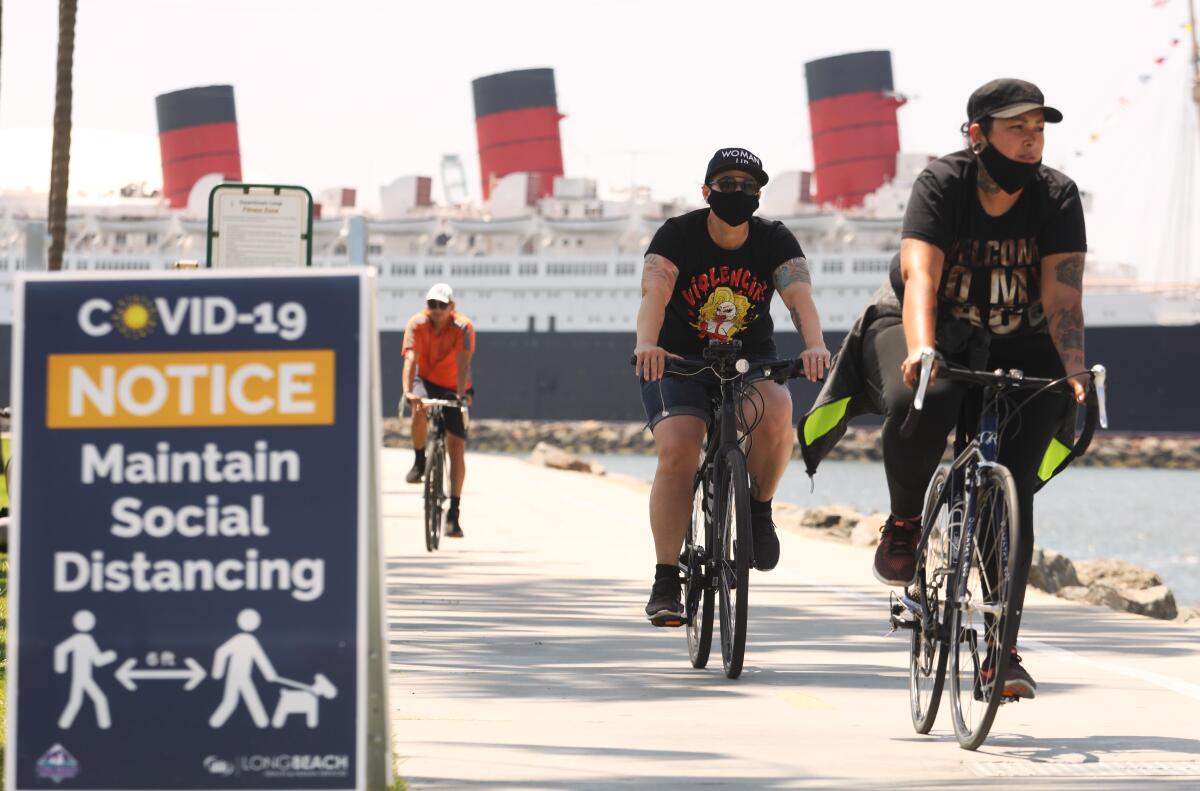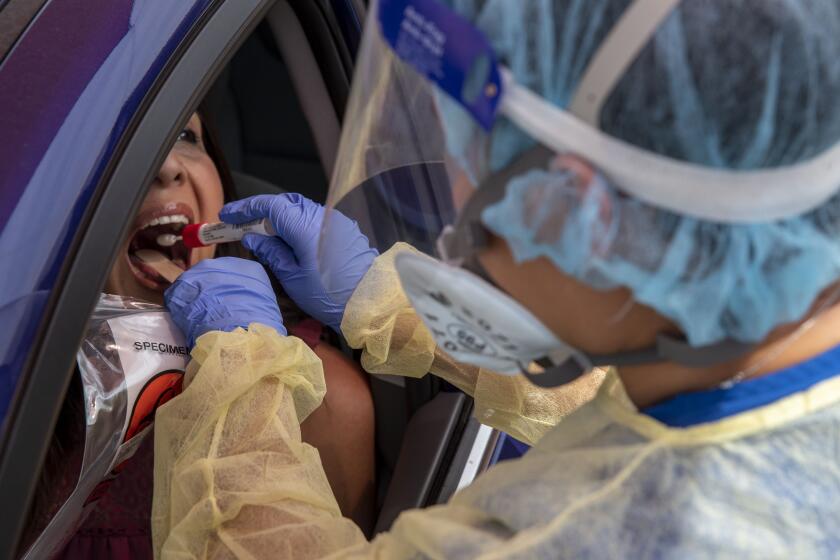The two big reasons why California is struggling to control coronavirus

- Share via
California hasn’t seen the huge death toll from the novel coronavirus like New York and other hot spots, but the state is still struggling with a growing number of fatalities and confirmed cases.
COVID-19 deaths in California remain at a stubborn plateau. Mirroring a trend seen nationally, California has not seen a sustained decline in deaths over the past month, a Los Angeles Times analysis found. During the seven-day period that ended Sunday, 503 people in California died from the virus — the second-highest weekly death toll in the course of the pandemic and a 1.6% increase from the previous week’s toll.
Los Angeles County’s stay-at-home orders will ‘with all certainty’ be extended for the next three months, Public Health Director Barbara Ferrer said.
The Times asked UC San Francisco epidemiologist and infectious disease expert Dr. George Rutherford, a former epidemic intelligence service officer with the U.S. Centers for Disease Control and Prevention, about why the plateau persists.
“As long as it’s going up, it has not ended. It’s got to come down for it to end,” he said.
Rutherford offered two reasons why the disease is persisting: a certain percentage of people still must go out to work, and others are getting fed up with staying at home.
For the last few months, grocery stores have served as public theaters for the traumatized American consumer.
Essential workers
A significant part of the population has chosen not to stay home or has been unable to do so because they’re essential workers manning supermarkets, meat processing plants, prisons and nursing homes.
A CDC study estimated that around April 1, about two weeks into a regional stay-at-home order, nearly 50% of residents in five Bay Area counties were still leaving home, down from 80% in late February.
“That’s still 50%,” Rutherford said, adding that people can still get infected even if they limit their trips outside the home to buy a loaf of bread at the supermarket.
Essential workers who must leave home — people working in the food industry, making deliveries and staffing medical facilities — are among those contracting the coronavirus.
A UC San Francisco study of thousands of residents and workers in the city’s Mission District found that 57% of those tested must leave their homes for work, and those who had to leave home to work accounted for 90% of the positive cases. Nearly 89% of those who tested positive earn less than $50,000 a year, and most live in households with three or more people.
While Latinos made up 44% of those tested, they accounted for more than 99% of the positive COVID-19 cases.
Many residents and workers in the Mission District are employed in essential services such as agriculture, construction, manufacturing, restaurants, grocery stores and janitorial and domestic services, the university said.
Staying home, the researchers said, clearly seemed to make a difference.
Large outbreaks have been reported at workplaces needed to keep essential businesses running, with dozens infected and at least one fatality at a Safeway distribution center east of the Bay Area in Tracy. Farther south in the Central Valley, at least 138 workers at a meat packing plant in Hanford have tested positive for the virus.
People in areas with high poverty rates have nearly four times as many deaths from COVID-19, L.A. County public health director Barbara Ferrer says.
L.A. County residents who live in areas with high poverty rates have nearly four times as many COVID-19 fatalities — 29 deaths per 100,000 people, compared with eight per 100,000 people in communities with low poverty rates, the county said last week.
Black and Latino Californians ages 18 to 64 are dying more frequently than their white and Asian counterparts relative to their share of the population, a Times analysis of state health department data conducted in late April found.
Rutherford said essential workers need to be considered, and he urged government officials to plan the reopening carefully.
“Make no mistake … the more the economy opens up, the more people are going to die,” he added. “You have to be really careful to minimize that number and make sure it’s not on the backs of all the poor people who are doing the front-line jobs who are going to get the most exposed.”
Latest far-right tactic: Naming names, threatening people who report coronavirus lockdown violations
A far-right group has posted names, email addresses and phone numbers of thousands of people who reported suspected violations of Washington state’s stay-at-home order.
Stay-at-home fatigue
Also a factor: People are getting fed up with the stay-at-home order and have been determined to enjoy the nice weather.
It’s a reason why disease forecasters are increasingly expecting the death toll to get worse than what was thought just a week ago. “They realized people weren’t really sheltering in place anymore and all the other states let their foot off the brakes,” Rutherford said.
Officials have expressed alarm at large crowds seen in San Francisco’s Mission Dolores Park, on Orange County beaches and in the downtown L.A. flower district.
There has been a steep rise in coronavirus cases reported in Orange County following the large crowds on the beaches on April 25-26.
In the week of April 20-26, there were 438 cases in Orange County. The week after that, 669 cases were reported, and the week after that, 759 cases. Further investigation is needed to determine whether the beaches were a source of spread for an outbreak or if the increase could be explained simply by other factors, such as increased testing.
“But you know, just us looking at it, there was a big jump in Orange County that was temporally consistent with possible transmission from that crowd event,” Rutherford said.
Others have voiced concern about crowded areas. “We are seeing spikes in infections in Southern California commensurate with when the beaches became crowded. We have seen spikes of infections when people have gone to large gatherings at churches or birthday parties. We must be vigilant,” the San Francisco director of public health, Dr. Grant Colfax, said Monday.
The Orange County health officer, Dr. Nichole Quick, said there’s no evidence at this time that crowded beaches were a factor in the rise in cases.
“As of now, that is not something we are pointing to as a cause of cases,” Quick said.
The crowds over the weekend of April 25 and 26 prompted Newsom to temporarily close Orang County’s beaches, a decision state officials said was meant to stave off potentially unsafe conditions that could worsen the spread of COVID-19.
The county began notably ramping up its daily screening activity starting around April 28.
“As we test more, we’re likely to pick up more cases,” Quick said.
Pasadena officials, on the other hand, have shown that forgoing social distancing can have bad results: a cluster of at least five coronavirus cases tied to a birthday party.
The party was held after Newsom issued the statewide stay-at-home order March 19 and was attended by a large number of extended family members and friends who did not wear face coverings or stay six feet apart, the city said in a news release.
“One person showed up to the party exhibiting symptoms and joking she may have the virus,” Lisa Derderian, spokeswoman for the city of Pasadena, said in an email. “The aftermath affected several others who became seriously ill because of one person’s negligent and selfish behavior.”
Through contact tracing, a Pasadena Public Health Department disease investigation team discovered more than five laboratory-confirmed coronavirus cases among attendees of the party “and many more ill individuals,” the city said. The team identified the woman as the index case, or the first patient in the outbreak identified with the infection, officials said.
11 photos: Businesses and restaurants open to customers in rural California counties.
At the same time, traffic is beginning to reappear in Los Angeles.
Congestion is still far below pre-pandemic levels, but the number of drivers who are out and about is steadily creeping upward, and travel times are retreating from the white-hot pace of late March, when the 405 Freeway saw speeds of 70 mph at rush hour.
Times staff writers Susanne Rust, Alex Wigglesworth and Patrick McGreevy contributed to this report.
More to Read
Sign up for Essential California
The most important California stories and recommendations in your inbox every morning.
You may occasionally receive promotional content from the Los Angeles Times.



















